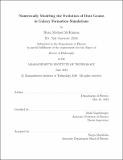Numerically modeling the evolution of dust grains in galaxy formation simulations
Author(s)
McKinnon, Ryan Michael.
Download1132722719-MIT.pdf (12.66Mb)
Other Contributors
Massachusetts Institute of Technology. Department of Physics.
Advisor
Mark Vogelsberger.
Terms of use
Metadata
Show full item recordAbstract
In this thesis, I present the development of various models for dust physics suited for galaxy formation simulations. I begin by introducing a model to evolve the spatial distribution of dust in galaxies, with dust treated as a passive scalar advected according to hydrodynamic flow. This model accounts for processes that affect the interstellar dust budget, like stellar dust production, accretion of gas-phase metals, and supernova-driven destruction. Using the moving-mesh hydrodynamics code arepo, I perform cosmological zoom-in simulations of Milky Way-sized galaxies to study the evolution of interstellar dust. Predictions from this model compare favorably to a number of observed low-redshift dust scaling relations and suggest that galactic dust-to-gas ratios can strongly increase with cosmic time. I also present simulations of uniformly sampled cosmological volumes to analyze the behavior of dust statistics on large scales. While these simulations predict a reasonable present-day cosmic dust density, they are unable to produce the abundance of dust-rich galaxies observed at high redshift. Next, I develop a model to more realistically track the dynamics and sizes of interstellar grains. This novel framework handles dust using live simulation particles, each representing a population of dust grains of different sizes and subject to dynamical forces like aerodynamic drag. I implement and validate a second-order semi-implicit integrator for the drag coupling between dust and gas, and I outline how the local size distribution of interstellar grains can be evolved using a second-order piecewise linear discretization. Using simulations of idealized galaxies, I illustrate how different physical processes affecting dust grain sizes would impact galactic extinction curves. Finally, I describe an extension of these methods to couple dust physics and radiation hydrodynamics in arepo-rt. This enables simulations to directly model radiation pressure on, photon absorption by, and thermal emission from dust grains. The framework introduced in this thesis can be used in the future to model other physics relevant for interstellar dust.
Description
This electronic version was submitted by the student author. The certified thesis is available in the Institute Archives and Special Collections. Thesis: Ph. D., Massachusetts Institute of Technology, Department of Physics, 2019 Cataloged from student-submitted PDF version of thesis. Includes bibliographical references (pages 239-254).
Date issued
2019Department
Massachusetts Institute of Technology. Department of PhysicsPublisher
Massachusetts Institute of Technology
Keywords
Physics.